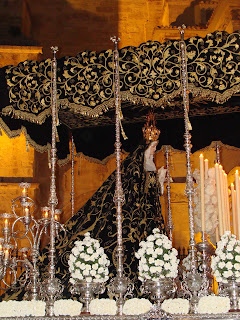 During Holy Week many Spanish towns and cities are filled
with processions remembering various bits of the story of the Passion, and parading
figures of Our Lady, Christ or representations of some of the mysteries through
the streets. In Seville, Murcia, Málaga and a few other places the Holy Week processions
are a religion, as it were. Here in my small city they aren’t quite in that
league, but they are of great cultural and social importance.
During Holy Week many Spanish towns and cities are filled
with processions remembering various bits of the story of the Passion, and parading
figures of Our Lady, Christ or representations of some of the mysteries through
the streets. In Seville, Murcia, Málaga and a few other places the Holy Week processions
are a religion, as it were. Here in my small city they aren’t quite in that
league, but they are of great cultural and social importance.
There were twenty-six different societies which went out
this week, the majority between Maundy Thursday and Good Friday. There is
considerably variety: some date from the 15thC, though most were formed less
than a hundred years ago. Most of the figures are carried on great platforms, beautifully
dressed and ornately decorated, surrounded by candles in silver sticks and
protected by exquisitely embroidered awnings. All of this weighs about a ton (very
roughly, I haven’t heard any accurate figures, but the things are HEAVY) and is
borne on the shoulders or backs of 40-50 big strong types who train all year
for it. They nearly all bring a band with them. A few have their own, but they
mostly hire a band to accompany their procession.
Some of these societies have hundreds of members, although
not all will process, some being old, infirm, lazy or otherwise engaged, but
those who do, the visible ones, will accompany the image in long lines, wearing
a long cape and tunic in the colours of the particular society, with a long
pointy hat covering their head and face, and carrying a large candle. These,
like the ‘costaleros’, are penitents, and they do their penance anonymously.
The religious significance is clear, but there is far more
to it than that. People who have no particular residue of devotion, or none at
all, often belong to one or more societies and carry or accompany their Virgins
and Christs each Easter because something moves them to do so. Families, groups
of friends, the members of trades and professions, often belong to the same
society and it is a part of their identity. Thousands of people, a significant
proportion of the population here, belong to these societies and are involved
in some way in the processions.
But many thousands more watch them. Those who don’t understand
what motivates people to do this, practical atheists or those who haven’t been
inside a church in years, recent immigrants from China or Morocco, line the
streets or crowd the balconies to watch the processions go past. They are a
public spectacle, treated as such, but also with great and instinctive respect.
Each time an image is raised in the air to continue walking (they have to rest
a lot and the coordination to lift it all together without it falling sideways-
it happens occasionally- is not easy to achieve) the public applauds. When the
image is stopped by someone moved to sing a ‘saeta’ to the statue, the image is
raised and danced by the bearers, and there is complete silence until the song
has ended.
 |
| El Cristo del Cachorro |
Mrs Hickory belongs to a society which goes out on Good
Friday evening, and has as its patron a Virgin of the Sorrows, a beautiful
image kept in the Cathedral during the year. They’ve been unlucky with the rain
in recent years, but this year they were able to parade her proudly through
most of the older part of town, and bring her back safely. Mrs Hickory is one
of the pointy hats and candles. I am her cornerman, following with water,
carbohydrates, aspirin, tobacco, camera, lighter and anything else she might
require.
The image was brought out of the Cathedral at 9 PMish, to the
sound of the National Anthem. The bearers bring Her out on their knees because,
with the fixed canopy above Her, She is too tall to get through the doors
otherwise. Then the whole procession, a couple of hundred people I would say,
makes its way through the streets for five hours, observed by the crowds on the
pavements. They take Her to visit the other two historic churches, and She
passes through the Main Square where she is greeted by a figure of Christ who’s
also out and about at that time.
The whole procession lasts about five hours until, at about
2 o’clock in the morning, they reach the Cathedral again and, to the
accompaniment of music which changes from cheerful over the last few hundred yards
to atmospheric and dramatic as She reaches home again. Then the exhausted
bearers turn Her around so she can salute the crowd once more, and take her
into the Cathedral, backwards, on their knees. Despite the cold and the
lateness of the hour there are always a few hundred people waiting to see the
Virgin, and a Christ which also lives in the Cathedral, and in most cases I don’t
think it is faith that took them there or the spectacle that attracted them,
but mostly the sense of being present at something which is part of their
lives, part of the place they belong to.


No comments:
Post a Comment